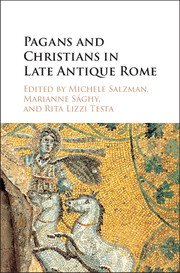 Pagans and Christians in Late Antique Rome
Pagans and Christians in Late Antique Rome Book contents
- Frontmatter
- Contents
- List of Illustrations
- Biographies of Authors
- Acknowledgments
- Introduction
- Part I SENATORIAL POLITICS AND RELIGIOUS CONFLICT
- Part II The Construction of New Religious Identities
- Part III Pagans and Christians: Coexistence and Competition
- Section A Pagans and Religious Practices in Christian Rome
- Section B Death and the Afterlife
- 12 Reinterpreting “Pagans” and “Christians” from Rome's Late Antique Mortuary Evidence
- 13 On the Form and Function of Constantine's Circiform Funerary Basilicas in Rome
- 14 Romanae gloria plebis: Bishop Damasus and the Traditions of Rome
- 15 Storytelling and Cultural Memory in the Making: Celebrating Pagan and Christian Founders of Rome
- Section C Reading Religious Iconography as Evidence for Pagan–Christian Relations
- Concluding Remarks: Vrbs Roma between Pagans and Christians
- Index
- References
15 - Storytelling and Cultural Memory in the Making: Celebrating Pagan and Christian Founders of Rome
from Section B - Death and the Afterlife
Published online by Cambridge University Press: 05 November 2015
- Frontmatter
- Contents
- List of Illustrations
- Biographies of Authors
- Acknowledgments
- Introduction
- Part I SENATORIAL POLITICS AND RELIGIOUS CONFLICT
- Part II The Construction of New Religious Identities
- Part III Pagans and Christians: Coexistence and Competition
- Section A Pagans and Religious Practices in Christian Rome
- Section B Death and the Afterlife
- 12 Reinterpreting “Pagans” and “Christians” from Rome's Late Antique Mortuary Evidence
- 13 On the Form and Function of Constantine's Circiform Funerary Basilicas in Rome
- 14 Romanae gloria plebis: Bishop Damasus and the Traditions of Rome
- 15 Storytelling and Cultural Memory in the Making: Celebrating Pagan and Christian Founders of Rome
- Section C Reading Religious Iconography as Evidence for Pagan–Christian Relations
- Concluding Remarks: Vrbs Roma between Pagans and Christians
- Index
- References
Summary
To understand the complex processes of change that Roman society underwent with the advent and expansion of Christianity, scholars of the late antique and early Christian period have used cultural memory theory as an interpretive model. Despite the criticisms that may be raised against this approach, from vagueness and lack of terminology, to theoretical exaggeration, the efforts (whether conscious or unconscious) of late Roman people to establish a new collectively shared memory about their Christian past may be detected in and across diverse groups of Christian Romans – from the lower and middle classes to senators and emperors. Such efforts may be seen in the establishment of narratives and commemorative practices with respect to the new Christian guardians of Rome: the apostles and the martyrs. This chapter will discuss one of these commemorations, the festival honoring the Apostles Peter and Paul on June 29, and the narratives supporting it – ancient as well as modern.
According to tradition, Peter and Paul were the founders of the Roman Church by their joint martyrdom at Rome. The memory of the two apostles was anchored to Rome by way of their graves, which were, in fact, called memoriae. These memoriae were monumentalized with shrines donated by emperors, praised by poets, and visited by pilgrims throughout the year, but especially around the annual festival on June 29. On this day, the reenactment of the memory of the Apostles also took place at the so-called Memoriae Apostolorum on the Via Appia, today's S. Sebastiano. Six hundred graffiti from the third century onward contain prayers of intercession devoted to Peter and Paul, thus testifying to a joint cult of these apostles – all year round. In the second half of the fourth century, the cult and the festival on June 29 was intensified by Pope Damasus (366–84) who composed an epigram for Peter and Paul at the Memoriae Apostolorum.
For more than two centuries, a considerable number of scholars have claimed that the celebration of Saints Peter and Paul on June 29 reflected an effort, during the third century, to appropriate an existing celebration on the same day of the divine founder of Rome, Romulus/Quirinus. In this chapter it will be argued, however, that this narrative about a Christian “usurpation” of a pagan celebration of Rome's foundation is a misguided modern construction of religious politics and cultural memory in fourth- and fifth-century Rome.
- Type
- Chapter
- Information
- Pagans and Christians in Late Antique RomeConflict, Competition, and Coexistence in the Fourth Century, pp. 330 - 342Publisher: Cambridge University PressPrint publication year: 2015


